Strategic Project Management: Success and Failure Analysis Report
VerifiedAdded on 2022/12/30
|13
|3755
|1
Report
AI Summary
This report provides a comprehensive analysis of project success factors and the causes of project failure, essential for strategic project management. The report begins by defining key criteria for project success, including the importance of the right team, effective planning, clear communication, and diligent risk management. It then delves into the common causes of project failure, such as poor planning, inadequate documentation, lack of experienced project managers, insufficient leadership, communication breakdowns, inaccurate budget estimations, and absent contingency plans. The report further explores the significance of the project scope and charter. Part 2 of the report analyzes two real-world case studies: the Accenture-Hertz lawsuit and the Optus Stadium project, examining the factors that contributed to their respective successes or failures. The analysis highlights the importance of proper planning, clear communication, and effective risk management in achieving successful project outcomes. The report concludes with recommendations for improving project management practices and avoiding common pitfalls, providing valuable insights for project managers and stakeholders.

1
Project Management
Project Management
Paraphrase This Document
Need a fresh take? Get an instant paraphrase of this document with our AI Paraphraser
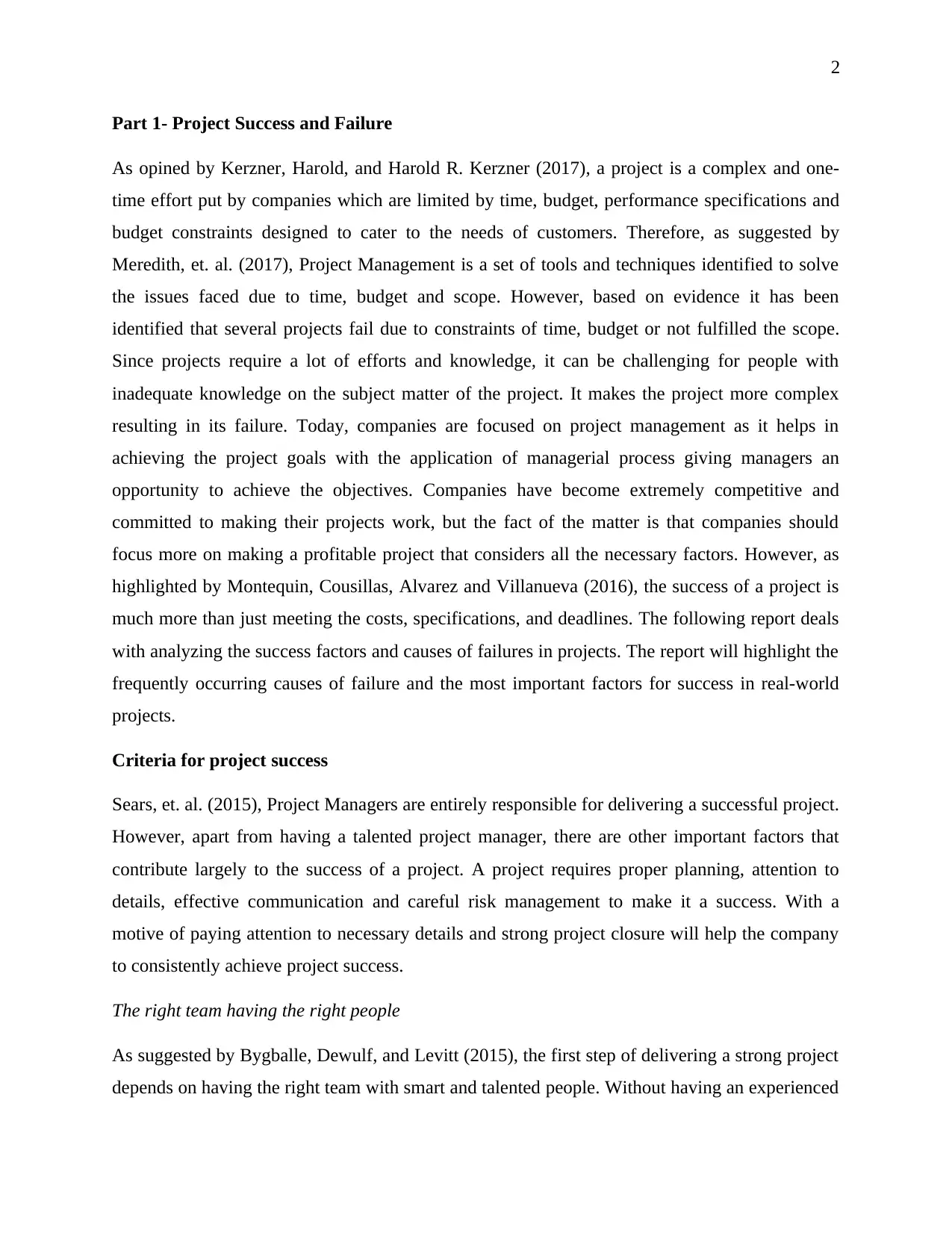
2
Part 1- Project Success and Failure
As opined by Kerzner, Harold, and Harold R. Kerzner (2017), a project is a complex and one-
time effort put by companies which are limited by time, budget, performance specifications and
budget constraints designed to cater to the needs of customers. Therefore, as suggested by
Meredith, et. al. (2017), Project Management is a set of tools and techniques identified to solve
the issues faced due to time, budget and scope. However, based on evidence it has been
identified that several projects fail due to constraints of time, budget or not fulfilled the scope.
Since projects require a lot of efforts and knowledge, it can be challenging for people with
inadequate knowledge on the subject matter of the project. It makes the project more complex
resulting in its failure. Today, companies are focused on project management as it helps in
achieving the project goals with the application of managerial process giving managers an
opportunity to achieve the objectives. Companies have become extremely competitive and
committed to making their projects work, but the fact of the matter is that companies should
focus more on making a profitable project that considers all the necessary factors. However, as
highlighted by Montequin, Cousillas, Alvarez and Villanueva (2016), the success of a project is
much more than just meeting the costs, specifications, and deadlines. The following report deals
with analyzing the success factors and causes of failures in projects. The report will highlight the
frequently occurring causes of failure and the most important factors for success in real-world
projects.
Criteria for project success
Sears, et. al. (2015), Project Managers are entirely responsible for delivering a successful project.
However, apart from having a talented project manager, there are other important factors that
contribute largely to the success of a project. A project requires proper planning, attention to
details, effective communication and careful risk management to make it a success. With a
motive of paying attention to necessary details and strong project closure will help the company
to consistently achieve project success.
The right team having the right people
As suggested by Bygballe, Dewulf, and Levitt (2015), the first step of delivering a strong project
depends on having the right team with smart and talented people. Without having an experienced
Part 1- Project Success and Failure
As opined by Kerzner, Harold, and Harold R. Kerzner (2017), a project is a complex and one-
time effort put by companies which are limited by time, budget, performance specifications and
budget constraints designed to cater to the needs of customers. Therefore, as suggested by
Meredith, et. al. (2017), Project Management is a set of tools and techniques identified to solve
the issues faced due to time, budget and scope. However, based on evidence it has been
identified that several projects fail due to constraints of time, budget or not fulfilled the scope.
Since projects require a lot of efforts and knowledge, it can be challenging for people with
inadequate knowledge on the subject matter of the project. It makes the project more complex
resulting in its failure. Today, companies are focused on project management as it helps in
achieving the project goals with the application of managerial process giving managers an
opportunity to achieve the objectives. Companies have become extremely competitive and
committed to making their projects work, but the fact of the matter is that companies should
focus more on making a profitable project that considers all the necessary factors. However, as
highlighted by Montequin, Cousillas, Alvarez and Villanueva (2016), the success of a project is
much more than just meeting the costs, specifications, and deadlines. The following report deals
with analyzing the success factors and causes of failures in projects. The report will highlight the
frequently occurring causes of failure and the most important factors for success in real-world
projects.
Criteria for project success
Sears, et. al. (2015), Project Managers are entirely responsible for delivering a successful project.
However, apart from having a talented project manager, there are other important factors that
contribute largely to the success of a project. A project requires proper planning, attention to
details, effective communication and careful risk management to make it a success. With a
motive of paying attention to necessary details and strong project closure will help the company
to consistently achieve project success.
The right team having the right people
As suggested by Bygballe, Dewulf, and Levitt (2015), the first step of delivering a strong project
depends on having the right team with smart and talented people. Without having an experienced
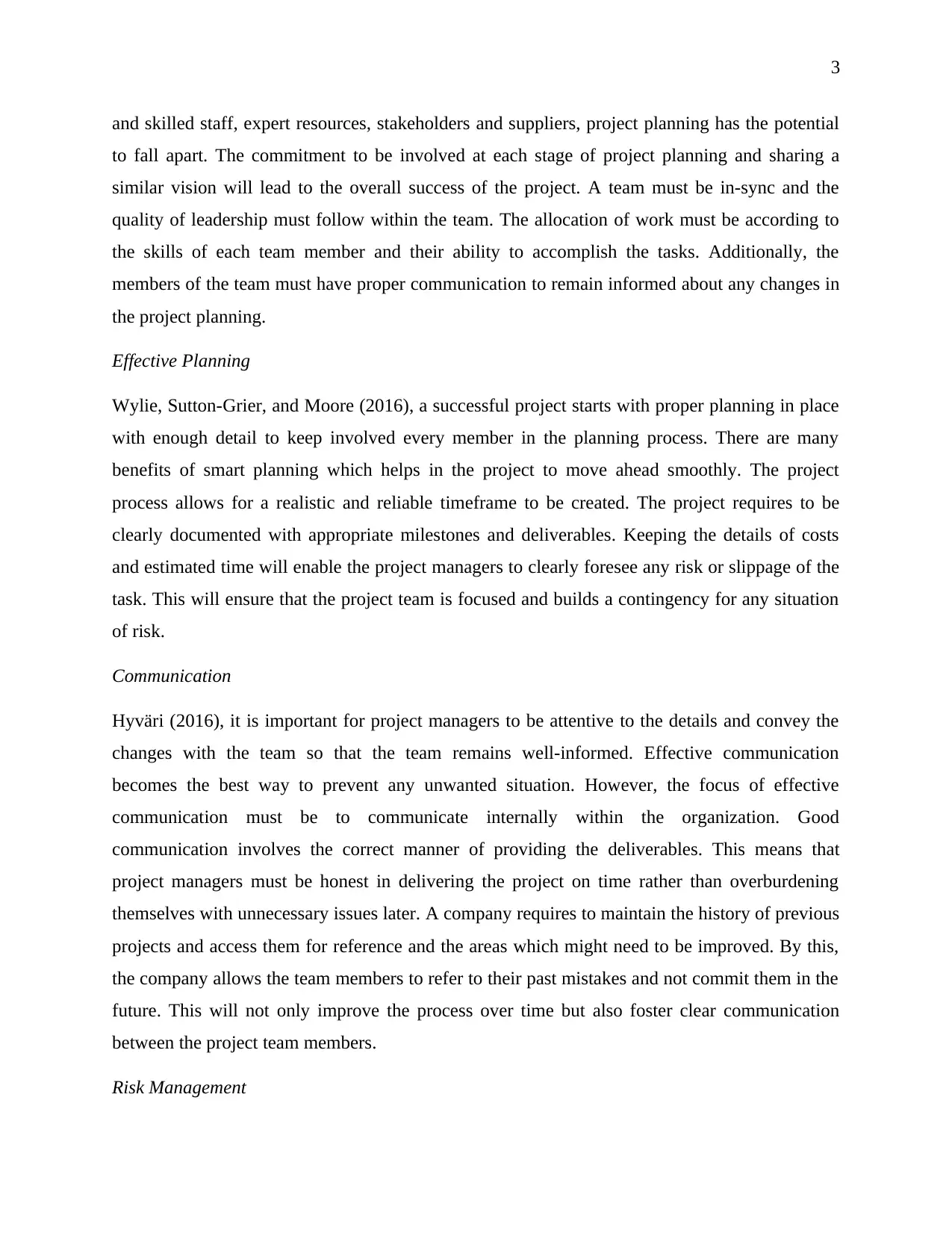
3
and skilled staff, expert resources, stakeholders and suppliers, project planning has the potential
to fall apart. The commitment to be involved at each stage of project planning and sharing a
similar vision will lead to the overall success of the project. A team must be in-sync and the
quality of leadership must follow within the team. The allocation of work must be according to
the skills of each team member and their ability to accomplish the tasks. Additionally, the
members of the team must have proper communication to remain informed about any changes in
the project planning.
Effective Planning
Wylie, Sutton-Grier, and Moore (2016), a successful project starts with proper planning in place
with enough detail to keep involved every member in the planning process. There are many
benefits of smart planning which helps in the project to move ahead smoothly. The project
process allows for a realistic and reliable timeframe to be created. The project requires to be
clearly documented with appropriate milestones and deliverables. Keeping the details of costs
and estimated time will enable the project managers to clearly foresee any risk or slippage of the
task. This will ensure that the project team is focused and builds a contingency for any situation
of risk.
Communication
Hyväri (2016), it is important for project managers to be attentive to the details and convey the
changes with the team so that the team remains well-informed. Effective communication
becomes the best way to prevent any unwanted situation. However, the focus of effective
communication must be to communicate internally within the organization. Good
communication involves the correct manner of providing the deliverables. This means that
project managers must be honest in delivering the project on time rather than overburdening
themselves with unnecessary issues later. A company requires to maintain the history of previous
projects and access them for reference and the areas which might need to be improved. By this,
the company allows the team members to refer to their past mistakes and not commit them in the
future. This will not only improve the process over time but also foster clear communication
between the project team members.
Risk Management
and skilled staff, expert resources, stakeholders and suppliers, project planning has the potential
to fall apart. The commitment to be involved at each stage of project planning and sharing a
similar vision will lead to the overall success of the project. A team must be in-sync and the
quality of leadership must follow within the team. The allocation of work must be according to
the skills of each team member and their ability to accomplish the tasks. Additionally, the
members of the team must have proper communication to remain informed about any changes in
the project planning.
Effective Planning
Wylie, Sutton-Grier, and Moore (2016), a successful project starts with proper planning in place
with enough detail to keep involved every member in the planning process. There are many
benefits of smart planning which helps in the project to move ahead smoothly. The project
process allows for a realistic and reliable timeframe to be created. The project requires to be
clearly documented with appropriate milestones and deliverables. Keeping the details of costs
and estimated time will enable the project managers to clearly foresee any risk or slippage of the
task. This will ensure that the project team is focused and builds a contingency for any situation
of risk.
Communication
Hyväri (2016), it is important for project managers to be attentive to the details and convey the
changes with the team so that the team remains well-informed. Effective communication
becomes the best way to prevent any unwanted situation. However, the focus of effective
communication must be to communicate internally within the organization. Good
communication involves the correct manner of providing the deliverables. This means that
project managers must be honest in delivering the project on time rather than overburdening
themselves with unnecessary issues later. A company requires to maintain the history of previous
projects and access them for reference and the areas which might need to be improved. By this,
the company allows the team members to refer to their past mistakes and not commit them in the
future. This will not only improve the process over time but also foster clear communication
between the project team members.
Risk Management
⊘ This is a preview!⊘
Do you want full access?
Subscribe today to unlock all pages.

Trusted by 1+ million students worldwide
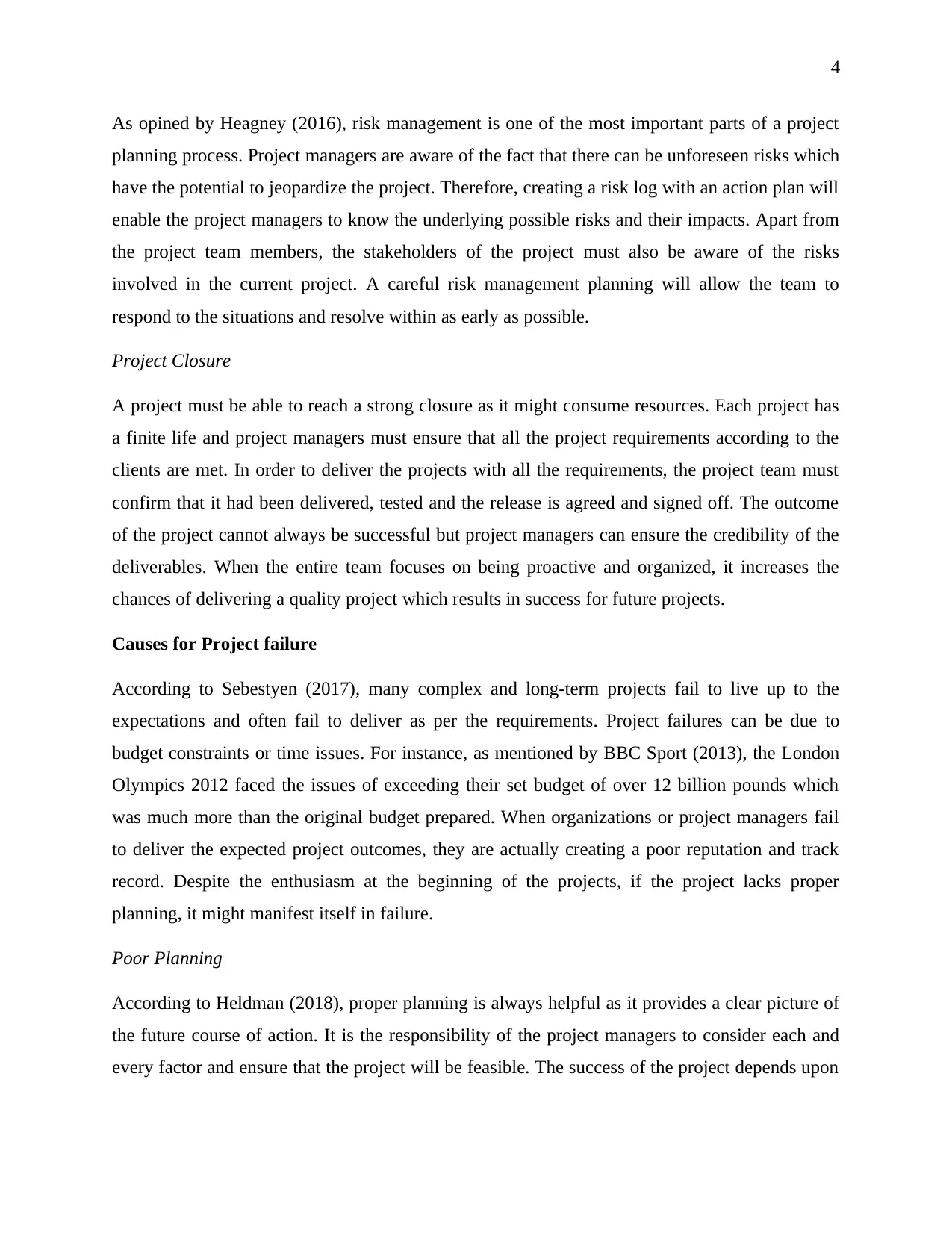
4
As opined by Heagney (2016), risk management is one of the most important parts of a project
planning process. Project managers are aware of the fact that there can be unforeseen risks which
have the potential to jeopardize the project. Therefore, creating a risk log with an action plan will
enable the project managers to know the underlying possible risks and their impacts. Apart from
the project team members, the stakeholders of the project must also be aware of the risks
involved in the current project. A careful risk management planning will allow the team to
respond to the situations and resolve within as early as possible.
Project Closure
A project must be able to reach a strong closure as it might consume resources. Each project has
a finite life and project managers must ensure that all the project requirements according to the
clients are met. In order to deliver the projects with all the requirements, the project team must
confirm that it had been delivered, tested and the release is agreed and signed off. The outcome
of the project cannot always be successful but project managers can ensure the credibility of the
deliverables. When the entire team focuses on being proactive and organized, it increases the
chances of delivering a quality project which results in success for future projects.
Causes for Project failure
According to Sebestyen (2017), many complex and long-term projects fail to live up to the
expectations and often fail to deliver as per the requirements. Project failures can be due to
budget constraints or time issues. For instance, as mentioned by BBC Sport (2013), the London
Olympics 2012 faced the issues of exceeding their set budget of over 12 billion pounds which
was much more than the original budget prepared. When organizations or project managers fail
to deliver the expected project outcomes, they are actually creating a poor reputation and track
record. Despite the enthusiasm at the beginning of the projects, if the project lacks proper
planning, it might manifest itself in failure.
Poor Planning
According to Heldman (2018), proper planning is always helpful as it provides a clear picture of
the future course of action. It is the responsibility of the project managers to consider each and
every factor and ensure that the project will be feasible. The success of the project depends upon
As opined by Heagney (2016), risk management is one of the most important parts of a project
planning process. Project managers are aware of the fact that there can be unforeseen risks which
have the potential to jeopardize the project. Therefore, creating a risk log with an action plan will
enable the project managers to know the underlying possible risks and their impacts. Apart from
the project team members, the stakeholders of the project must also be aware of the risks
involved in the current project. A careful risk management planning will allow the team to
respond to the situations and resolve within as early as possible.
Project Closure
A project must be able to reach a strong closure as it might consume resources. Each project has
a finite life and project managers must ensure that all the project requirements according to the
clients are met. In order to deliver the projects with all the requirements, the project team must
confirm that it had been delivered, tested and the release is agreed and signed off. The outcome
of the project cannot always be successful but project managers can ensure the credibility of the
deliverables. When the entire team focuses on being proactive and organized, it increases the
chances of delivering a quality project which results in success for future projects.
Causes for Project failure
According to Sebestyen (2017), many complex and long-term projects fail to live up to the
expectations and often fail to deliver as per the requirements. Project failures can be due to
budget constraints or time issues. For instance, as mentioned by BBC Sport (2013), the London
Olympics 2012 faced the issues of exceeding their set budget of over 12 billion pounds which
was much more than the original budget prepared. When organizations or project managers fail
to deliver the expected project outcomes, they are actually creating a poor reputation and track
record. Despite the enthusiasm at the beginning of the projects, if the project lacks proper
planning, it might manifest itself in failure.
Poor Planning
According to Heldman (2018), proper planning is always helpful as it provides a clear picture of
the future course of action. It is the responsibility of the project managers to consider each and
every factor and ensure that the project will be feasible. The success of the project depends upon
Paraphrase This Document
Need a fresh take? Get an instant paraphrase of this document with our AI Paraphraser
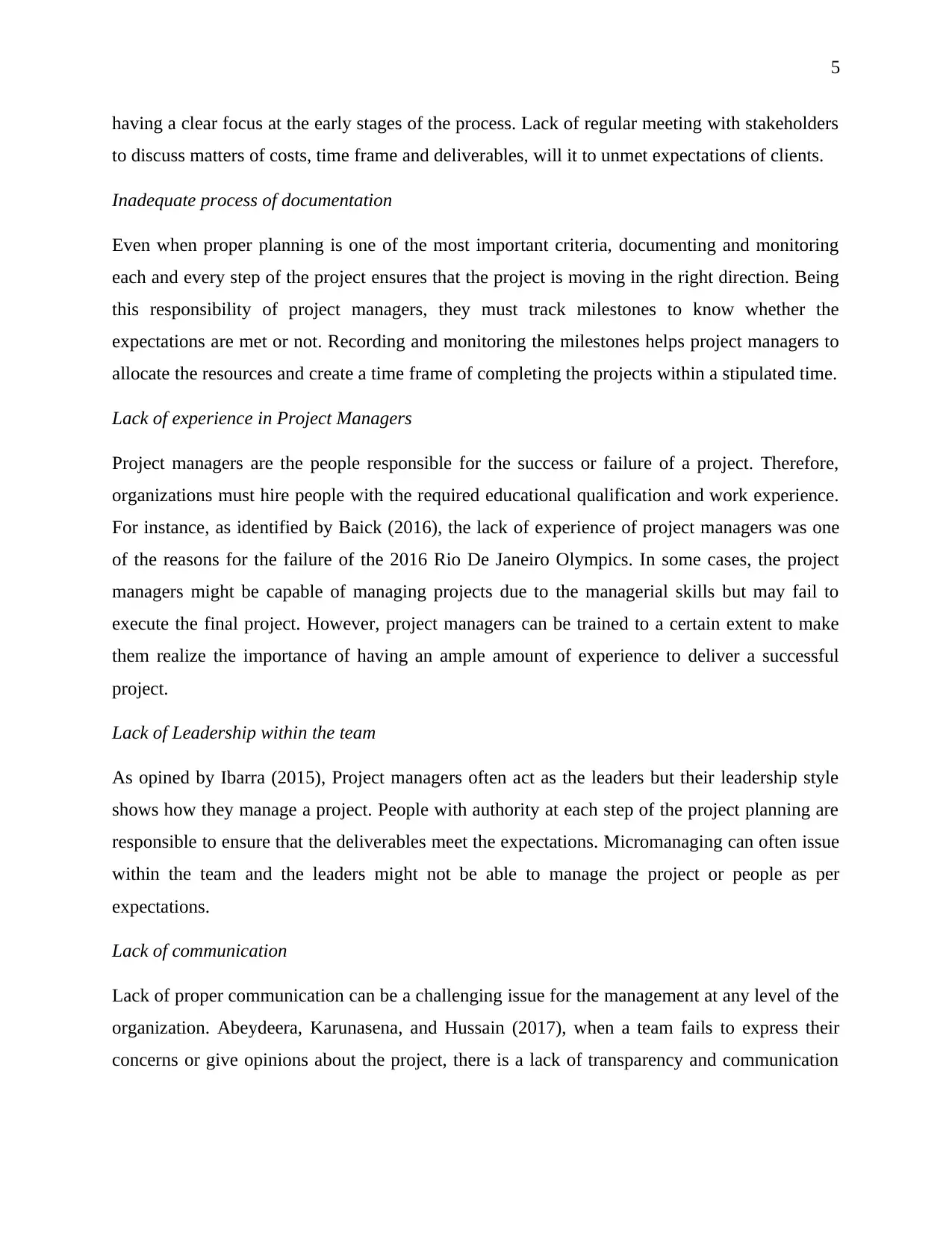
5
having a clear focus at the early stages of the process. Lack of regular meeting with stakeholders
to discuss matters of costs, time frame and deliverables, will it to unmet expectations of clients.
Inadequate process of documentation
Even when proper planning is one of the most important criteria, documenting and monitoring
each and every step of the project ensures that the project is moving in the right direction. Being
this responsibility of project managers, they must track milestones to know whether the
expectations are met or not. Recording and monitoring the milestones helps project managers to
allocate the resources and create a time frame of completing the projects within a stipulated time.
Lack of experience in Project Managers
Project managers are the people responsible for the success or failure of a project. Therefore,
organizations must hire people with the required educational qualification and work experience.
For instance, as identified by Baick (2016), the lack of experience of project managers was one
of the reasons for the failure of the 2016 Rio De Janeiro Olympics. In some cases, the project
managers might be capable of managing projects due to the managerial skills but may fail to
execute the final project. However, project managers can be trained to a certain extent to make
them realize the importance of having an ample amount of experience to deliver a successful
project.
Lack of Leadership within the team
As opined by Ibarra (2015), Project managers often act as the leaders but their leadership style
shows how they manage a project. People with authority at each step of the project planning are
responsible to ensure that the deliverables meet the expectations. Micromanaging can often issue
within the team and the leaders might not be able to manage the project or people as per
expectations.
Lack of communication
Lack of proper communication can be a challenging issue for the management at any level of the
organization. Abeydeera, Karunasena, and Hussain (2017), when a team fails to express their
concerns or give opinions about the project, there is a lack of transparency and communication
having a clear focus at the early stages of the process. Lack of regular meeting with stakeholders
to discuss matters of costs, time frame and deliverables, will it to unmet expectations of clients.
Inadequate process of documentation
Even when proper planning is one of the most important criteria, documenting and monitoring
each and every step of the project ensures that the project is moving in the right direction. Being
this responsibility of project managers, they must track milestones to know whether the
expectations are met or not. Recording and monitoring the milestones helps project managers to
allocate the resources and create a time frame of completing the projects within a stipulated time.
Lack of experience in Project Managers
Project managers are the people responsible for the success or failure of a project. Therefore,
organizations must hire people with the required educational qualification and work experience.
For instance, as identified by Baick (2016), the lack of experience of project managers was one
of the reasons for the failure of the 2016 Rio De Janeiro Olympics. In some cases, the project
managers might be capable of managing projects due to the managerial skills but may fail to
execute the final project. However, project managers can be trained to a certain extent to make
them realize the importance of having an ample amount of experience to deliver a successful
project.
Lack of Leadership within the team
As opined by Ibarra (2015), Project managers often act as the leaders but their leadership style
shows how they manage a project. People with authority at each step of the project planning are
responsible to ensure that the deliverables meet the expectations. Micromanaging can often issue
within the team and the leaders might not be able to manage the project or people as per
expectations.
Lack of communication
Lack of proper communication can be a challenging issue for the management at any level of the
organization. Abeydeera, Karunasena, and Hussain (2017), when a team fails to express their
concerns or give opinions about the project, there is a lack of transparency and communication
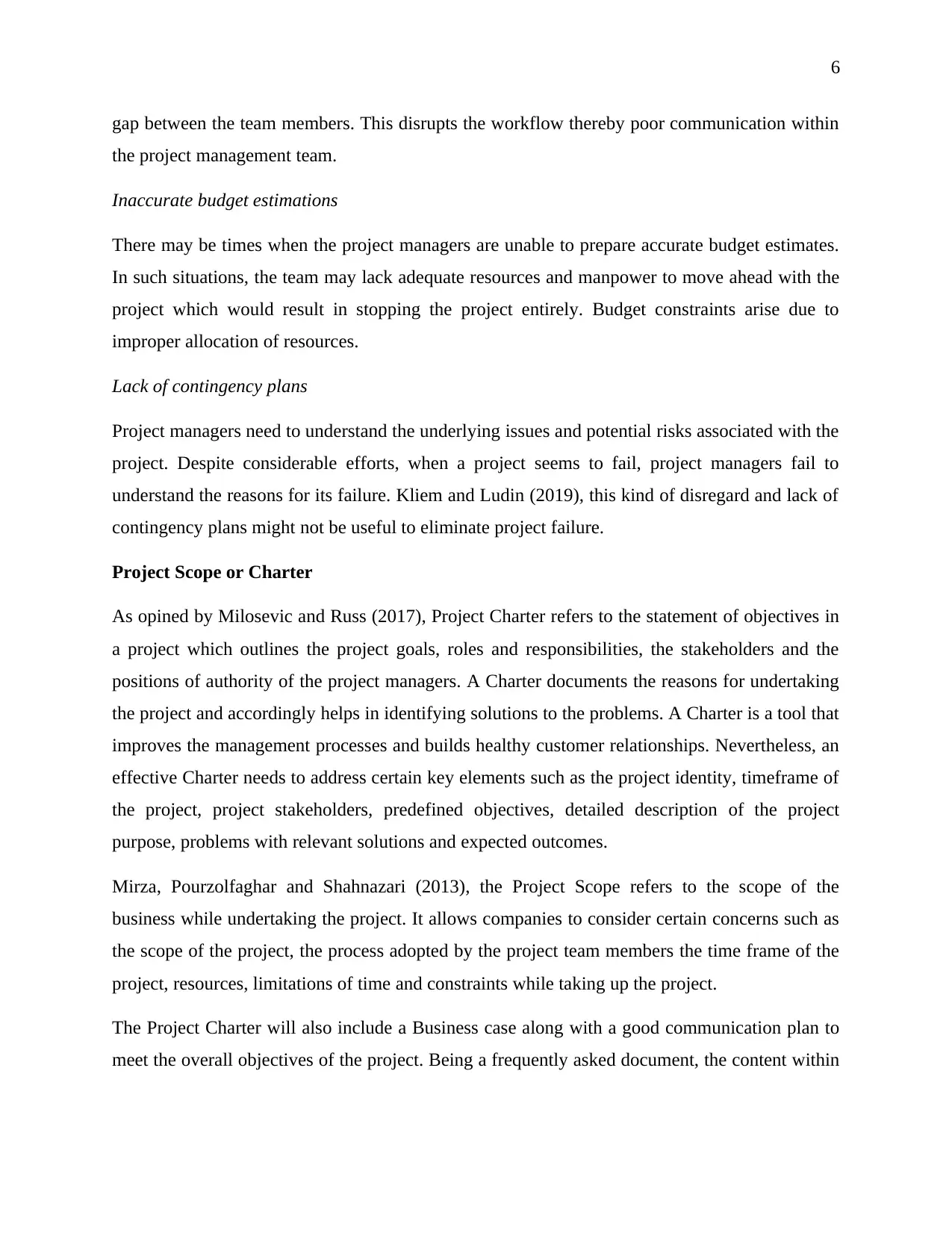
6
gap between the team members. This disrupts the workflow thereby poor communication within
the project management team.
Inaccurate budget estimations
There may be times when the project managers are unable to prepare accurate budget estimates.
In such situations, the team may lack adequate resources and manpower to move ahead with the
project which would result in stopping the project entirely. Budget constraints arise due to
improper allocation of resources.
Lack of contingency plans
Project managers need to understand the underlying issues and potential risks associated with the
project. Despite considerable efforts, when a project seems to fail, project managers fail to
understand the reasons for its failure. Kliem and Ludin (2019), this kind of disregard and lack of
contingency plans might not be useful to eliminate project failure.
Project Scope or Charter
As opined by Milosevic and Russ (2017), Project Charter refers to the statement of objectives in
a project which outlines the project goals, roles and responsibilities, the stakeholders and the
positions of authority of the project managers. A Charter documents the reasons for undertaking
the project and accordingly helps in identifying solutions to the problems. A Charter is a tool that
improves the management processes and builds healthy customer relationships. Nevertheless, an
effective Charter needs to address certain key elements such as the project identity, timeframe of
the project, project stakeholders, predefined objectives, detailed description of the project
purpose, problems with relevant solutions and expected outcomes.
Mirza, Pourzolfaghar and Shahnazari (2013), the Project Scope refers to the scope of the
business while undertaking the project. It allows companies to consider certain concerns such as
the scope of the project, the process adopted by the project team members the time frame of the
project, resources, limitations of time and constraints while taking up the project.
The Project Charter will also include a Business case along with a good communication plan to
meet the overall objectives of the project. Being a frequently asked document, the content within
gap between the team members. This disrupts the workflow thereby poor communication within
the project management team.
Inaccurate budget estimations
There may be times when the project managers are unable to prepare accurate budget estimates.
In such situations, the team may lack adequate resources and manpower to move ahead with the
project which would result in stopping the project entirely. Budget constraints arise due to
improper allocation of resources.
Lack of contingency plans
Project managers need to understand the underlying issues and potential risks associated with the
project. Despite considerable efforts, when a project seems to fail, project managers fail to
understand the reasons for its failure. Kliem and Ludin (2019), this kind of disregard and lack of
contingency plans might not be useful to eliminate project failure.
Project Scope or Charter
As opined by Milosevic and Russ (2017), Project Charter refers to the statement of objectives in
a project which outlines the project goals, roles and responsibilities, the stakeholders and the
positions of authority of the project managers. A Charter documents the reasons for undertaking
the project and accordingly helps in identifying solutions to the problems. A Charter is a tool that
improves the management processes and builds healthy customer relationships. Nevertheless, an
effective Charter needs to address certain key elements such as the project identity, timeframe of
the project, project stakeholders, predefined objectives, detailed description of the project
purpose, problems with relevant solutions and expected outcomes.
Mirza, Pourzolfaghar and Shahnazari (2013), the Project Scope refers to the scope of the
business while undertaking the project. It allows companies to consider certain concerns such as
the scope of the project, the process adopted by the project team members the time frame of the
project, resources, limitations of time and constraints while taking up the project.
The Project Charter will also include a Business case along with a good communication plan to
meet the overall objectives of the project. Being a frequently asked document, the content within
⊘ This is a preview!⊘
Do you want full access?
Subscribe today to unlock all pages.

Trusted by 1+ million students worldwide
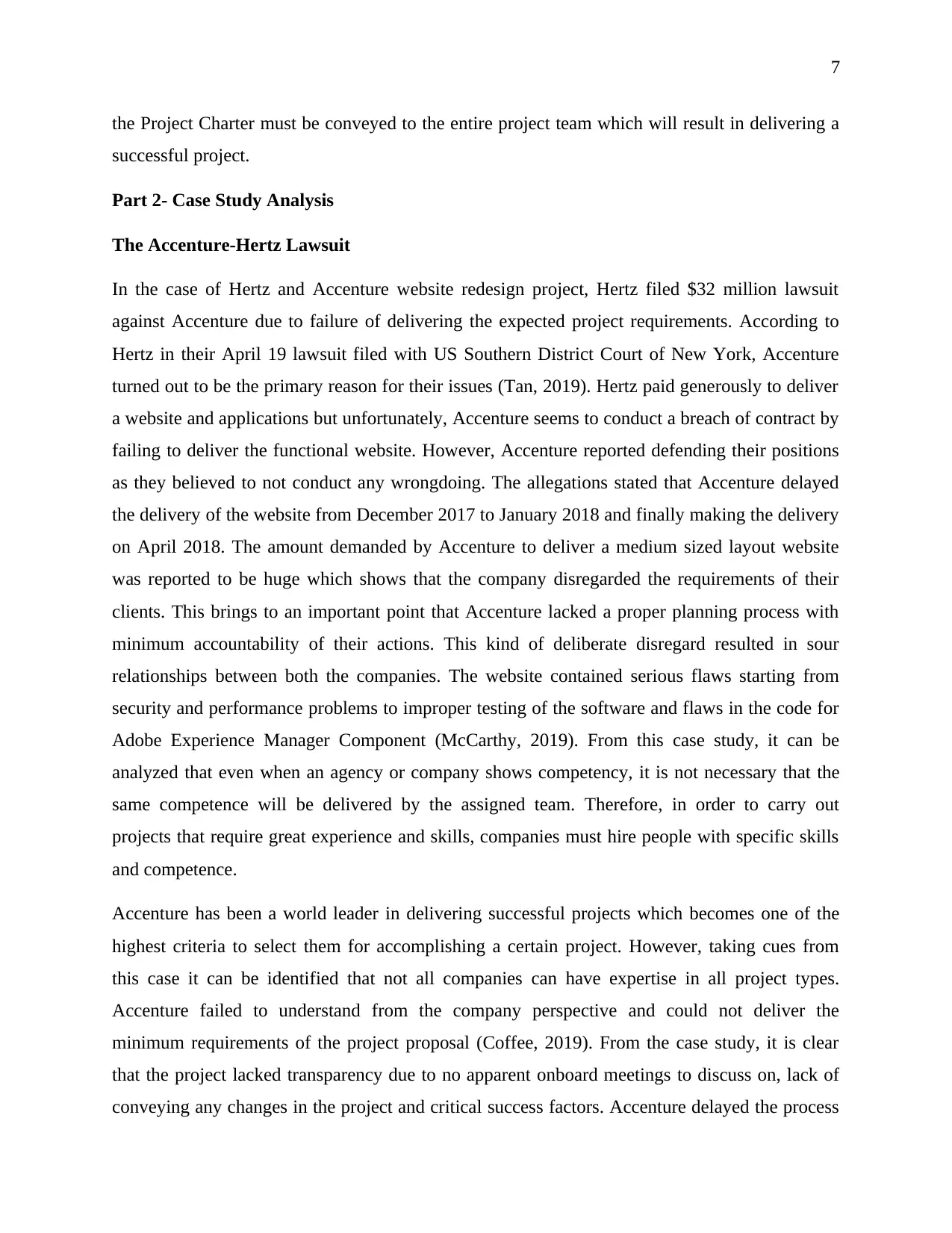
7
the Project Charter must be conveyed to the entire project team which will result in delivering a
successful project.
Part 2- Case Study Analysis
The Accenture-Hertz Lawsuit
In the case of Hertz and Accenture website redesign project, Hertz filed $32 million lawsuit
against Accenture due to failure of delivering the expected project requirements. According to
Hertz in their April 19 lawsuit filed with US Southern District Court of New York, Accenture
turned out to be the primary reason for their issues (Tan, 2019). Hertz paid generously to deliver
a website and applications but unfortunately, Accenture seems to conduct a breach of contract by
failing to deliver the functional website. However, Accenture reported defending their positions
as they believed to not conduct any wrongdoing. The allegations stated that Accenture delayed
the delivery of the website from December 2017 to January 2018 and finally making the delivery
on April 2018. The amount demanded by Accenture to deliver a medium sized layout website
was reported to be huge which shows that the company disregarded the requirements of their
clients. This brings to an important point that Accenture lacked a proper planning process with
minimum accountability of their actions. This kind of deliberate disregard resulted in sour
relationships between both the companies. The website contained serious flaws starting from
security and performance problems to improper testing of the software and flaws in the code for
Adobe Experience Manager Component (McCarthy, 2019). From this case study, it can be
analyzed that even when an agency or company shows competency, it is not necessary that the
same competence will be delivered by the assigned team. Therefore, in order to carry out
projects that require great experience and skills, companies must hire people with specific skills
and competence.
Accenture has been a world leader in delivering successful projects which becomes one of the
highest criteria to select them for accomplishing a certain project. However, taking cues from
this case it can be identified that not all companies can have expertise in all project types.
Accenture failed to understand from the company perspective and could not deliver the
minimum requirements of the project proposal (Coffee, 2019). From the case study, it is clear
that the project lacked transparency due to no apparent onboard meetings to discuss on, lack of
conveying any changes in the project and critical success factors. Accenture delayed the process
the Project Charter must be conveyed to the entire project team which will result in delivering a
successful project.
Part 2- Case Study Analysis
The Accenture-Hertz Lawsuit
In the case of Hertz and Accenture website redesign project, Hertz filed $32 million lawsuit
against Accenture due to failure of delivering the expected project requirements. According to
Hertz in their April 19 lawsuit filed with US Southern District Court of New York, Accenture
turned out to be the primary reason for their issues (Tan, 2019). Hertz paid generously to deliver
a website and applications but unfortunately, Accenture seems to conduct a breach of contract by
failing to deliver the functional website. However, Accenture reported defending their positions
as they believed to not conduct any wrongdoing. The allegations stated that Accenture delayed
the delivery of the website from December 2017 to January 2018 and finally making the delivery
on April 2018. The amount demanded by Accenture to deliver a medium sized layout website
was reported to be huge which shows that the company disregarded the requirements of their
clients. This brings to an important point that Accenture lacked a proper planning process with
minimum accountability of their actions. This kind of deliberate disregard resulted in sour
relationships between both the companies. The website contained serious flaws starting from
security and performance problems to improper testing of the software and flaws in the code for
Adobe Experience Manager Component (McCarthy, 2019). From this case study, it can be
analyzed that even when an agency or company shows competency, it is not necessary that the
same competence will be delivered by the assigned team. Therefore, in order to carry out
projects that require great experience and skills, companies must hire people with specific skills
and competence.
Accenture has been a world leader in delivering successful projects which becomes one of the
highest criteria to select them for accomplishing a certain project. However, taking cues from
this case it can be identified that not all companies can have expertise in all project types.
Accenture failed to understand from the company perspective and could not deliver the
minimum requirements of the project proposal (Coffee, 2019). From the case study, it is clear
that the project lacked transparency due to no apparent onboard meetings to discuss on, lack of
conveying any changes in the project and critical success factors. Accenture delayed the process
Paraphrase This Document
Need a fresh take? Get an instant paraphrase of this document with our AI Paraphraser
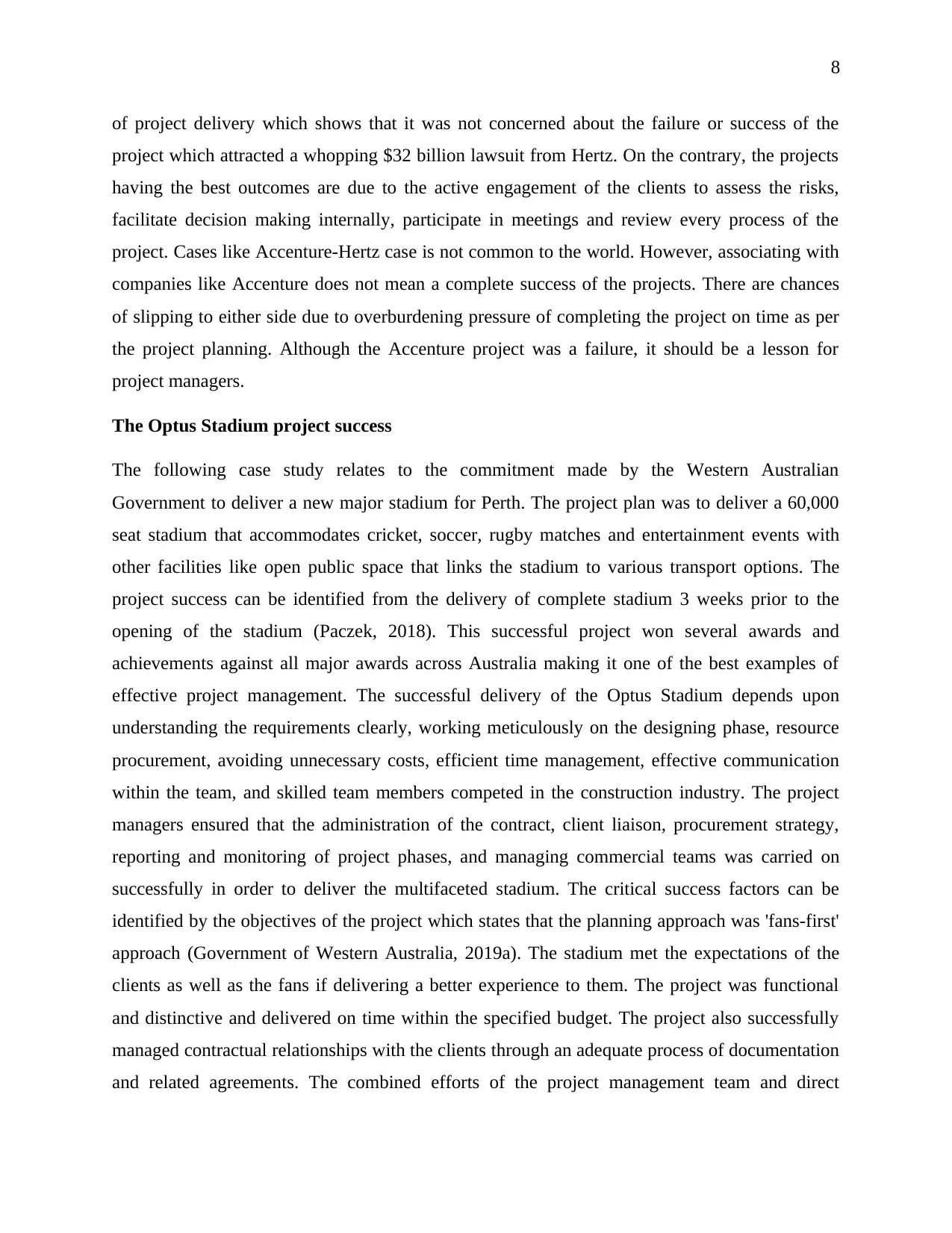
8
of project delivery which shows that it was not concerned about the failure or success of the
project which attracted a whopping $32 billion lawsuit from Hertz. On the contrary, the projects
having the best outcomes are due to the active engagement of the clients to assess the risks,
facilitate decision making internally, participate in meetings and review every process of the
project. Cases like Accenture-Hertz case is not common to the world. However, associating with
companies like Accenture does not mean a complete success of the projects. There are chances
of slipping to either side due to overburdening pressure of completing the project on time as per
the project planning. Although the Accenture project was a failure, it should be a lesson for
project managers.
The Optus Stadium project success
The following case study relates to the commitment made by the Western Australian
Government to deliver a new major stadium for Perth. The project plan was to deliver a 60,000
seat stadium that accommodates cricket, soccer, rugby matches and entertainment events with
other facilities like open public space that links the stadium to various transport options. The
project success can be identified from the delivery of complete stadium 3 weeks prior to the
opening of the stadium (Paczek, 2018). This successful project won several awards and
achievements against all major awards across Australia making it one of the best examples of
effective project management. The successful delivery of the Optus Stadium depends upon
understanding the requirements clearly, working meticulously on the designing phase, resource
procurement, avoiding unnecessary costs, efficient time management, effective communication
within the team, and skilled team members competed in the construction industry. The project
managers ensured that the administration of the contract, client liaison, procurement strategy,
reporting and monitoring of project phases, and managing commercial teams was carried on
successfully in order to deliver the multifaceted stadium. The critical success factors can be
identified by the objectives of the project which states that the planning approach was 'fans-first'
approach (Government of Western Australia, 2019a). The stadium met the expectations of the
clients as well as the fans if delivering a better experience to them. The project was functional
and distinctive and delivered on time within the specified budget. The project also successfully
managed contractual relationships with the clients through an adequate process of documentation
and related agreements. The combined efforts of the project management team and direct
of project delivery which shows that it was not concerned about the failure or success of the
project which attracted a whopping $32 billion lawsuit from Hertz. On the contrary, the projects
having the best outcomes are due to the active engagement of the clients to assess the risks,
facilitate decision making internally, participate in meetings and review every process of the
project. Cases like Accenture-Hertz case is not common to the world. However, associating with
companies like Accenture does not mean a complete success of the projects. There are chances
of slipping to either side due to overburdening pressure of completing the project on time as per
the project planning. Although the Accenture project was a failure, it should be a lesson for
project managers.
The Optus Stadium project success
The following case study relates to the commitment made by the Western Australian
Government to deliver a new major stadium for Perth. The project plan was to deliver a 60,000
seat stadium that accommodates cricket, soccer, rugby matches and entertainment events with
other facilities like open public space that links the stadium to various transport options. The
project success can be identified from the delivery of complete stadium 3 weeks prior to the
opening of the stadium (Paczek, 2018). This successful project won several awards and
achievements against all major awards across Australia making it one of the best examples of
effective project management. The successful delivery of the Optus Stadium depends upon
understanding the requirements clearly, working meticulously on the designing phase, resource
procurement, avoiding unnecessary costs, efficient time management, effective communication
within the team, and skilled team members competed in the construction industry. The project
managers ensured that the administration of the contract, client liaison, procurement strategy,
reporting and monitoring of project phases, and managing commercial teams was carried on
successfully in order to deliver the multifaceted stadium. The critical success factors can be
identified by the objectives of the project which states that the planning approach was 'fans-first'
approach (Government of Western Australia, 2019a). The stadium met the expectations of the
clients as well as the fans if delivering a better experience to them. The project was functional
and distinctive and delivered on time within the specified budget. The project also successfully
managed contractual relationships with the clients through an adequate process of documentation
and related agreements. The combined efforts of the project management team and direct
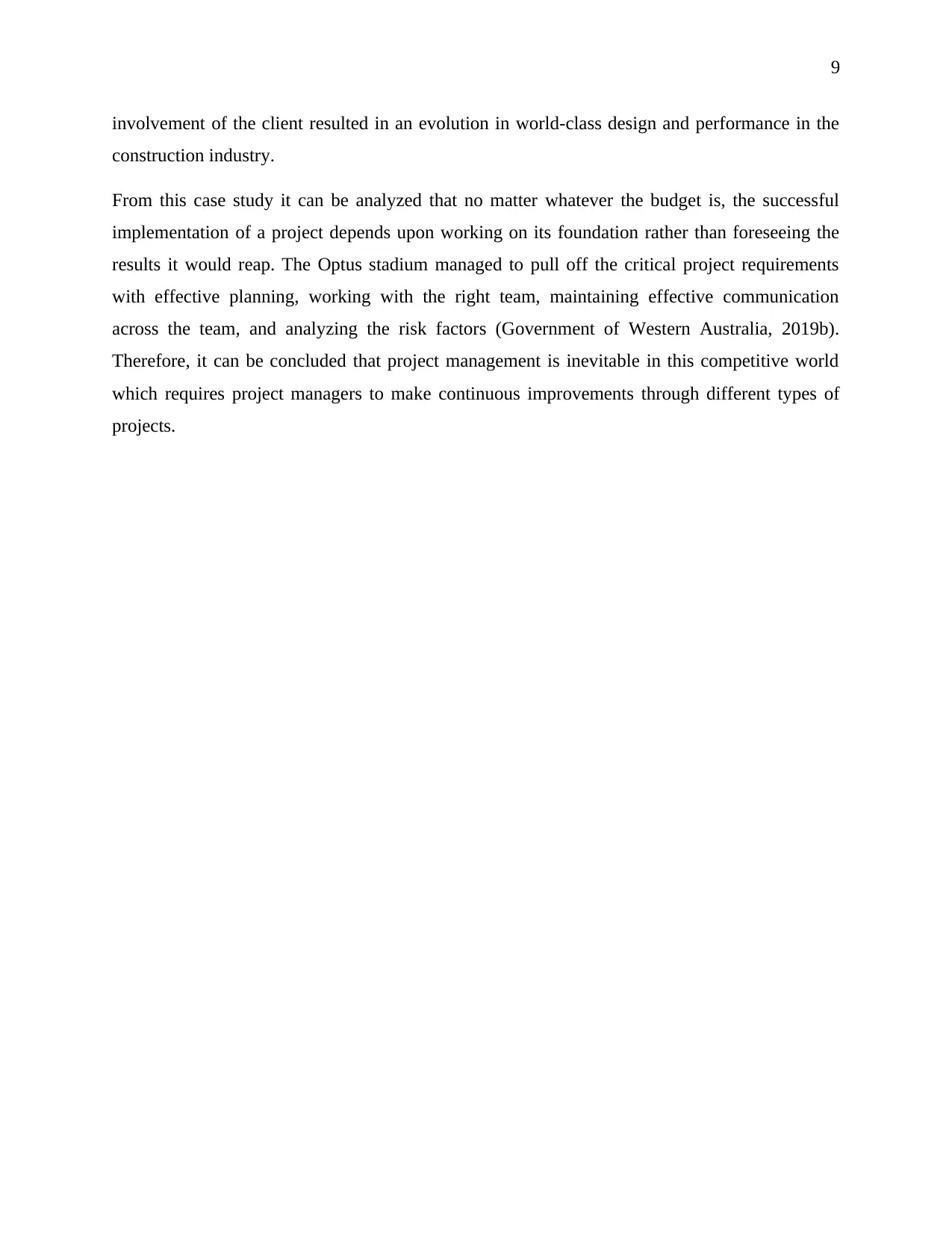
9
involvement of the client resulted in an evolution in world-class design and performance in the
construction industry.
From this case study it can be analyzed that no matter whatever the budget is, the successful
implementation of a project depends upon working on its foundation rather than foreseeing the
results it would reap. The Optus stadium managed to pull off the critical project requirements
with effective planning, working with the right team, maintaining effective communication
across the team, and analyzing the risk factors (Government of Western Australia, 2019b).
Therefore, it can be concluded that project management is inevitable in this competitive world
which requires project managers to make continuous improvements through different types of
projects.
involvement of the client resulted in an evolution in world-class design and performance in the
construction industry.
From this case study it can be analyzed that no matter whatever the budget is, the successful
implementation of a project depends upon working on its foundation rather than foreseeing the
results it would reap. The Optus stadium managed to pull off the critical project requirements
with effective planning, working with the right team, maintaining effective communication
across the team, and analyzing the risk factors (Government of Western Australia, 2019b).
Therefore, it can be concluded that project management is inevitable in this competitive world
which requires project managers to make continuous improvements through different types of
projects.
⊘ This is a preview!⊘
Do you want full access?
Subscribe today to unlock all pages.

Trusted by 1+ million students worldwide
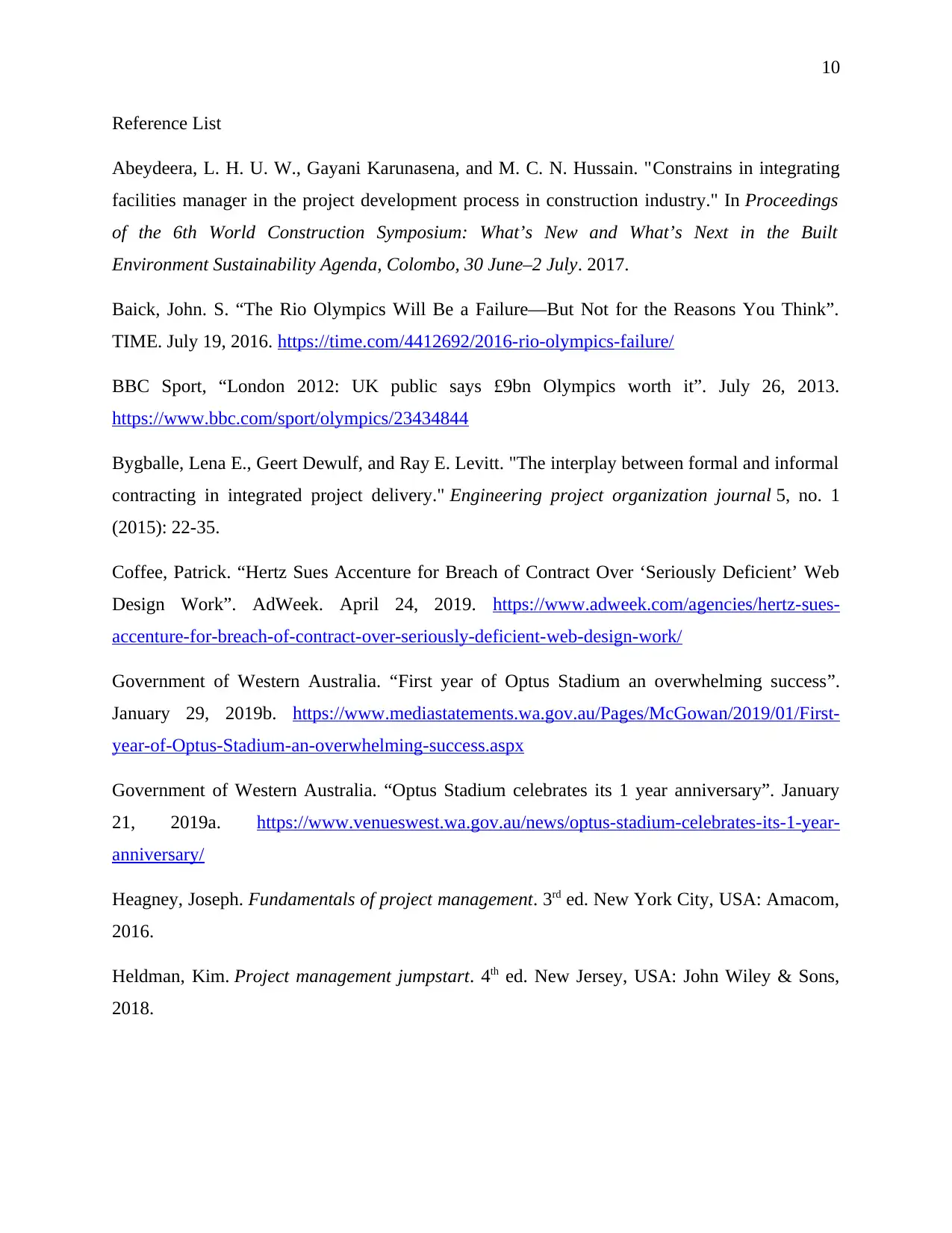
10
Reference List
Abeydeera, L. H. U. W., Gayani Karunasena, and M. C. N. Hussain. "Constrains in integrating
facilities manager in the project development process in construction industry." In Proceedings
of the 6th World Construction Symposium: What’s New and What’s Next in the Built
Environment Sustainability Agenda, Colombo, 30 June–2 July. 2017.
Baick, John. S. “The Rio Olympics Will Be a Failure—But Not for the Reasons You Think”.
TIME. July 19, 2016. https://time.com/4412692/2016-rio-olympics-failure/
BBC Sport, “London 2012: UK public says £9bn Olympics worth it”. July 26, 2013.
https://www.bbc.com/sport/olympics/23434844
Bygballe, Lena E., Geert Dewulf, and Ray E. Levitt. "The interplay between formal and informal
contracting in integrated project delivery." Engineering project organization journal 5, no. 1
(2015): 22-35.
Coffee, Patrick. “Hertz Sues Accenture for Breach of Contract Over ‘Seriously Deficient’ Web
Design Work”. AdWeek. April 24, 2019. https://www.adweek.com/agencies/hertz-sues-
accenture-for-breach-of-contract-over-seriously-deficient-web-design-work/
Government of Western Australia. “First year of Optus Stadium an overwhelming success”.
January 29, 2019b. https://www.mediastatements.wa.gov.au/Pages/McGowan/2019/01/First-
year-of-Optus-Stadium-an-overwhelming-success.aspx
Government of Western Australia. “Optus Stadium celebrates its 1 year anniversary”. January
21, 2019a. https://www.venueswest.wa.gov.au/news/optus-stadium-celebrates-its-1-year-
anniversary/
Heagney, Joseph. Fundamentals of project management. 3rd ed. New York City, USA: Amacom,
2016.
Heldman, Kim. Project management jumpstart. 4th ed. New Jersey, USA: John Wiley & Sons,
2018.
Reference List
Abeydeera, L. H. U. W., Gayani Karunasena, and M. C. N. Hussain. "Constrains in integrating
facilities manager in the project development process in construction industry." In Proceedings
of the 6th World Construction Symposium: What’s New and What’s Next in the Built
Environment Sustainability Agenda, Colombo, 30 June–2 July. 2017.
Baick, John. S. “The Rio Olympics Will Be a Failure—But Not for the Reasons You Think”.
TIME. July 19, 2016. https://time.com/4412692/2016-rio-olympics-failure/
BBC Sport, “London 2012: UK public says £9bn Olympics worth it”. July 26, 2013.
https://www.bbc.com/sport/olympics/23434844
Bygballe, Lena E., Geert Dewulf, and Ray E. Levitt. "The interplay between formal and informal
contracting in integrated project delivery." Engineering project organization journal 5, no. 1
(2015): 22-35.
Coffee, Patrick. “Hertz Sues Accenture for Breach of Contract Over ‘Seriously Deficient’ Web
Design Work”. AdWeek. April 24, 2019. https://www.adweek.com/agencies/hertz-sues-
accenture-for-breach-of-contract-over-seriously-deficient-web-design-work/
Government of Western Australia. “First year of Optus Stadium an overwhelming success”.
January 29, 2019b. https://www.mediastatements.wa.gov.au/Pages/McGowan/2019/01/First-
year-of-Optus-Stadium-an-overwhelming-success.aspx
Government of Western Australia. “Optus Stadium celebrates its 1 year anniversary”. January
21, 2019a. https://www.venueswest.wa.gov.au/news/optus-stadium-celebrates-its-1-year-
anniversary/
Heagney, Joseph. Fundamentals of project management. 3rd ed. New York City, USA: Amacom,
2016.
Heldman, Kim. Project management jumpstart. 4th ed. New Jersey, USA: John Wiley & Sons,
2018.
Paraphrase This Document
Need a fresh take? Get an instant paraphrase of this document with our AI Paraphraser
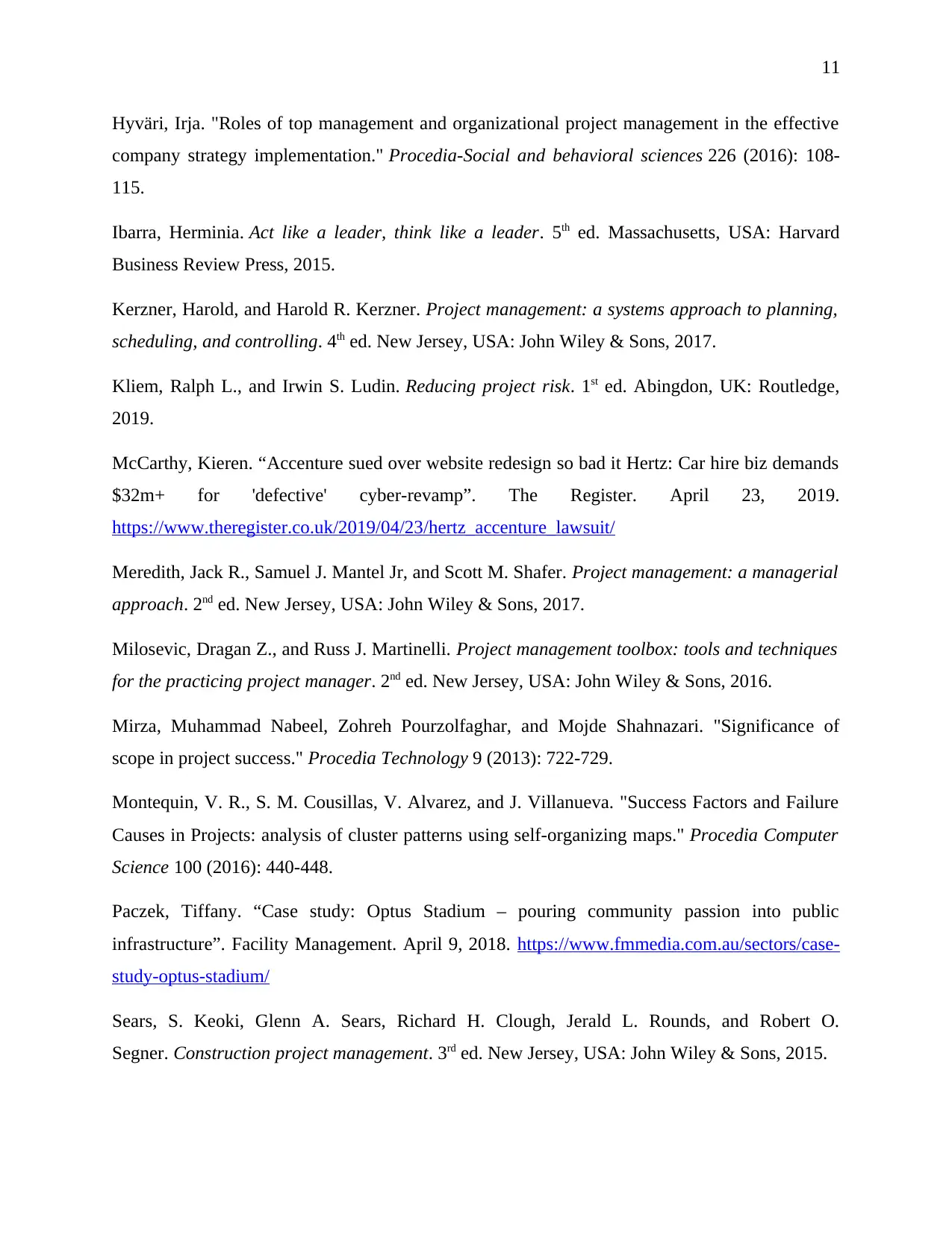
11
Hyväri, Irja. "Roles of top management and organizational project management in the effective
company strategy implementation." Procedia-Social and behavioral sciences 226 (2016): 108-
115.
Ibarra, Herminia. Act like a leader, think like a leader. 5th ed. Massachusetts, USA: Harvard
Business Review Press, 2015.
Kerzner, Harold, and Harold R. Kerzner. Project management: a systems approach to planning,
scheduling, and controlling. 4th ed. New Jersey, USA: John Wiley & Sons, 2017.
Kliem, Ralph L., and Irwin S. Ludin. Reducing project risk. 1st ed. Abingdon, UK: Routledge,
2019.
McCarthy, Kieren. “Accenture sued over website redesign so bad it Hertz: Car hire biz demands
$32m+ for 'defective' cyber-revamp”. The Register. April 23, 2019.
https://www.theregister.co.uk/2019/04/23/hertz_accenture_lawsuit/
Meredith, Jack R., Samuel J. Mantel Jr, and Scott M. Shafer. Project management: a managerial
approach. 2nd ed. New Jersey, USA: John Wiley & Sons, 2017.
Milosevic, Dragan Z., and Russ J. Martinelli. Project management toolbox: tools and techniques
for the practicing project manager. 2nd ed. New Jersey, USA: John Wiley & Sons, 2016.
Mirza, Muhammad Nabeel, Zohreh Pourzolfaghar, and Mojde Shahnazari. "Significance of
scope in project success." Procedia Technology 9 (2013): 722-729.
Montequin, V. R., S. M. Cousillas, V. Alvarez, and J. Villanueva. "Success Factors and Failure
Causes in Projects: analysis of cluster patterns using self-organizing maps." Procedia Computer
Science 100 (2016): 440-448.
Paczek, Tiffany. “Case study: Optus Stadium – pouring community passion into public
infrastructure”. Facility Management. April 9, 2018. https://www.fmmedia.com.au/sectors/case-
study-optus-stadium/
Sears, S. Keoki, Glenn A. Sears, Richard H. Clough, Jerald L. Rounds, and Robert O.
Segner. Construction project management. 3rd ed. New Jersey, USA: John Wiley & Sons, 2015.
Hyväri, Irja. "Roles of top management and organizational project management in the effective
company strategy implementation." Procedia-Social and behavioral sciences 226 (2016): 108-
115.
Ibarra, Herminia. Act like a leader, think like a leader. 5th ed. Massachusetts, USA: Harvard
Business Review Press, 2015.
Kerzner, Harold, and Harold R. Kerzner. Project management: a systems approach to planning,
scheduling, and controlling. 4th ed. New Jersey, USA: John Wiley & Sons, 2017.
Kliem, Ralph L., and Irwin S. Ludin. Reducing project risk. 1st ed. Abingdon, UK: Routledge,
2019.
McCarthy, Kieren. “Accenture sued over website redesign so bad it Hertz: Car hire biz demands
$32m+ for 'defective' cyber-revamp”. The Register. April 23, 2019.
https://www.theregister.co.uk/2019/04/23/hertz_accenture_lawsuit/
Meredith, Jack R., Samuel J. Mantel Jr, and Scott M. Shafer. Project management: a managerial
approach. 2nd ed. New Jersey, USA: John Wiley & Sons, 2017.
Milosevic, Dragan Z., and Russ J. Martinelli. Project management toolbox: tools and techniques
for the practicing project manager. 2nd ed. New Jersey, USA: John Wiley & Sons, 2016.
Mirza, Muhammad Nabeel, Zohreh Pourzolfaghar, and Mojde Shahnazari. "Significance of
scope in project success." Procedia Technology 9 (2013): 722-729.
Montequin, V. R., S. M. Cousillas, V. Alvarez, and J. Villanueva. "Success Factors and Failure
Causes in Projects: analysis of cluster patterns using self-organizing maps." Procedia Computer
Science 100 (2016): 440-448.
Paczek, Tiffany. “Case study: Optus Stadium – pouring community passion into public
infrastructure”. Facility Management. April 9, 2018. https://www.fmmedia.com.au/sectors/case-
study-optus-stadium/
Sears, S. Keoki, Glenn A. Sears, Richard H. Clough, Jerald L. Rounds, and Robert O.
Segner. Construction project management. 3rd ed. New Jersey, USA: John Wiley & Sons, 2015.
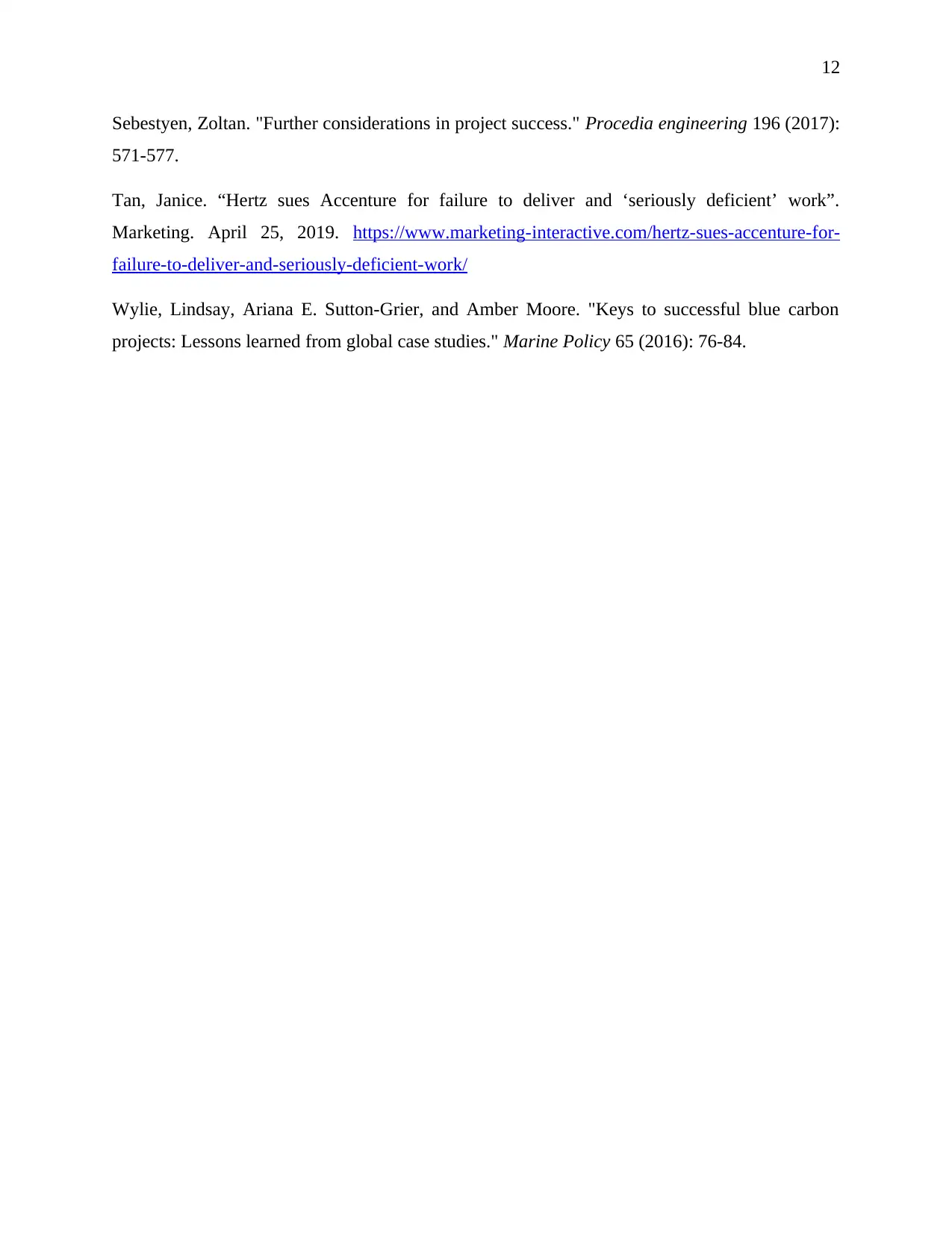
12
Sebestyen, Zoltan. "Further considerations in project success." Procedia engineering 196 (2017):
571-577.
Tan, Janice. “Hertz sues Accenture for failure to deliver and ‘seriously deficient’ work”.
Marketing. April 25, 2019. https://www.marketing-interactive.com/hertz-sues-accenture-for-
failure-to-deliver-and-seriously-deficient-work/
Wylie, Lindsay, Ariana E. Sutton-Grier, and Amber Moore. "Keys to successful blue carbon
projects: Lessons learned from global case studies." Marine Policy 65 (2016): 76-84.
Sebestyen, Zoltan. "Further considerations in project success." Procedia engineering 196 (2017):
571-577.
Tan, Janice. “Hertz sues Accenture for failure to deliver and ‘seriously deficient’ work”.
Marketing. April 25, 2019. https://www.marketing-interactive.com/hertz-sues-accenture-for-
failure-to-deliver-and-seriously-deficient-work/
Wylie, Lindsay, Ariana E. Sutton-Grier, and Amber Moore. "Keys to successful blue carbon
projects: Lessons learned from global case studies." Marine Policy 65 (2016): 76-84.
⊘ This is a preview!⊘
Do you want full access?
Subscribe today to unlock all pages.

Trusted by 1+ million students worldwide
1 out of 13
Related Documents
Your All-in-One AI-Powered Toolkit for Academic Success.
+13062052269
info@desklib.com
Available 24*7 on WhatsApp / Email
![[object Object]](/_next/static/media/star-bottom.7253800d.svg)
Unlock your academic potential
Copyright © 2020–2025 A2Z Services. All Rights Reserved. Developed and managed by ZUCOL.




